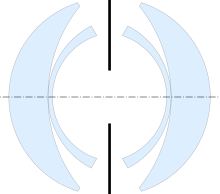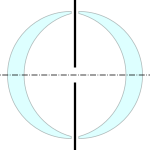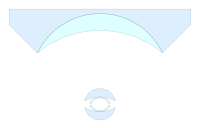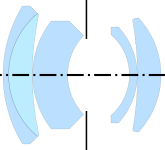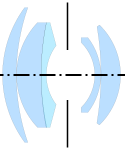
A twin-lens reflex camera (TLR) is a type of camera with two objective lenses of the same focal length. One of the lenses is the photographic objective or "taking lens", while the other is used for the viewfinder system, which is usually viewed from above at waist level.

The Angénieux retrofocus photographic lens is a wide-angle lens design that uses an inverted telephoto configuration. The popularity of this lens design made the name retrofocus synonymous with this type of lens. The Angénieux retrofocus for still cameras was introduced in France in 1950 by Pierre Angénieux.

Carl Zeiss AG, branded as ZEISS, is a German manufacturer of optical systems and optoelectronics, founded in Jena, Germany in 1846 by optician Carl Zeiss. Together with Ernst Abbe and Otto Schott he laid the foundation for today's multi-national company. The current company emerged from a reunification of Carl Zeiss companies in East and West Germany with a consolidation phase in the 1990s. ZEISS is active in four business segments with approximately equal revenue in almost 50 countries, has 30 production sites and around 25 development sites worldwide.
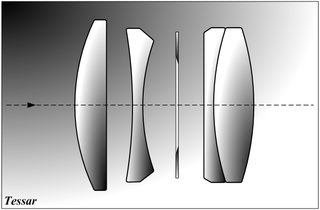
The Tessar is a photographic lens design conceived by the German physicist Dr. Paul Rudolph in 1902 while he worked at the Zeiss optical company and patented by Zeiss in Germany; the lens type is usually known as the ZeissTessar. Since its introduction, millions of Tessar and Tessar-derived lenses have been manufactured by Zeiss and other manufacturers, and are still produced as excellent intermediate aperture lenses.

A fisheye lens is an ultra wide-angle lens that produces strong visual distortion intended to create a wide panoramic or hemispherical image. Fisheye lenses achieve extremely wide angles of view, well beyond any rectilinear lens. Instead of producing images with straight lines of perspective, fisheye lenses use a special mapping, which gives images a characteristic convex non-rectilinear appearance.

Voigtländer was a significant long-established company within the optics and photographic industry, headquartered in Braunschweig, Germany, and today continues as a trademark for a range of photographic products.

Rollei was a German manufacturer of optical instruments founded in 1920 by Paul Franke and Reinhold Heidecke in Braunschweig, Lower Saxony, and maker of the Rolleiflex and Rolleicord series of cameras. Later products included specialty and nostalgic type films for the photo hobbyist market.

Metrogon is a high resolution, low-distortion, extra-wide field photographic lens design, popularized by Bausch and Lomb. Variations of this design were used extensively by the US military for aerial photography, fitted to the T-11 and other aerial cameras.
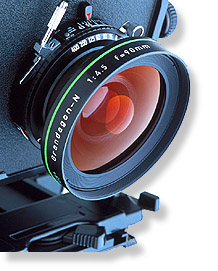
Large format lenses are photographic optics that provide an image circle large enough to cover the large format film or plates used in large format cameras.

The Rolleiflex SL35 is a range of SLR cameras manufactured and sold by the German camera maker Rollei from 1970 to 1982. This range of cameras uses 35mm film. The camera bodies were initially made in Germany. After Zeiss Ikon discontinued camera production, Rollei acquired the Voigtländer brand and camera designs in 1972, and began producing a second generation of SLR cameras in Singapore starting from 1976. Some of those second-generation cameras were rebranded and marketed as Voigtländer VSL.
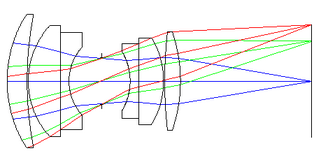
The double Gauss lens is a compound lens used mostly in camera lenses that reduces optical aberrations over a large focal plane.

The Zeiss Planar is a photographic lens designed by Paul Rudolph at Carl Zeiss in 1896. Rudolph's original was a six-element symmetrical double Gauss lens design.
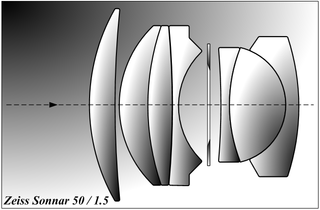
The Zeiss Sonnar is a photographic lens originally designed by Dr. Ludwig Bertele in 1929 and patented by Zeiss Ikon. It was notable for its relatively light weight, simple design and fast aperture.
The design of photographic lenses for use in still or cine cameras is intended to produce a lens that yields the most acceptable rendition of the subject being photographed within a range of constraints that include cost, weight and materials. For many other optical devices such as telescopes, microscopes and theodolites where the visual image is observed but often not recorded the design can often be significantly simpler than is the case in a camera where every image is captured on film or image sensor and can be subject to detailed scrutiny at a later stage. Photographic lenses also include those used in enlargers and projectors.

Biogon is the brand name of Carl Zeiss for a series of photographic camera lenses, first introduced in 1934. Biogons are typically wide-angle lenses.

Ludwig Jakob Bertele was a German optics constructor. His developments received universal recognition and serve as a basis for considerable part of the optical designs used today.

The invention of the camera in the early 19th century led to an array of lens designs intended for photography. The problems of photographic lens design, creating a lens for a task that would cover a large, flat image plane, were well known even before the invention of photography due to the development of lenses to work with the focal plane of the camera obscura.
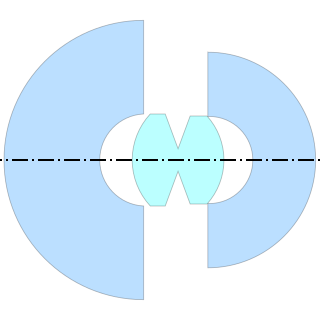
The Zeiss Hologon is an ultra wide-angle f=15mm f/8 triplet lens, providing a 110° angle of view for 35mm format cameras. The Hologon was originally fitted to a dedicated camera, the Zeiss Ikon Contarex Hologon in the late 1960s; as sales of that camera were poor and the Zeiss Ikon company itself was going bankrupt, an additional 225 lenses were made in Leica M mount and released for sale in 1972 as the only Zeiss-branded lenses for Leica rangefinders until the ZM line was released in 2005. The Hologon name was revived in 1994 for a recomputed f=16mm f/8 lens fitted to the Contax G series of rangefinder cameras.

The Vitessa was a line of 35mm compact rangefinder cameras made by Voigtländer in the 1950s, equipped with leaf shutters, similar in concept to and marketed against the competing Kodak Retina cameras manufactured by Kodak. Most of the Vitessa cameras were fixed-lens models equipped with collapsable lenses for portability. One of the later Vitessa models, the Vitessa T (1956), introduced the Deckel (DKL) bayonet mount for interchangeable photographic lenses.

Prominent refers to two distinct lines of rangefinder cameras made by Voigtländer.
